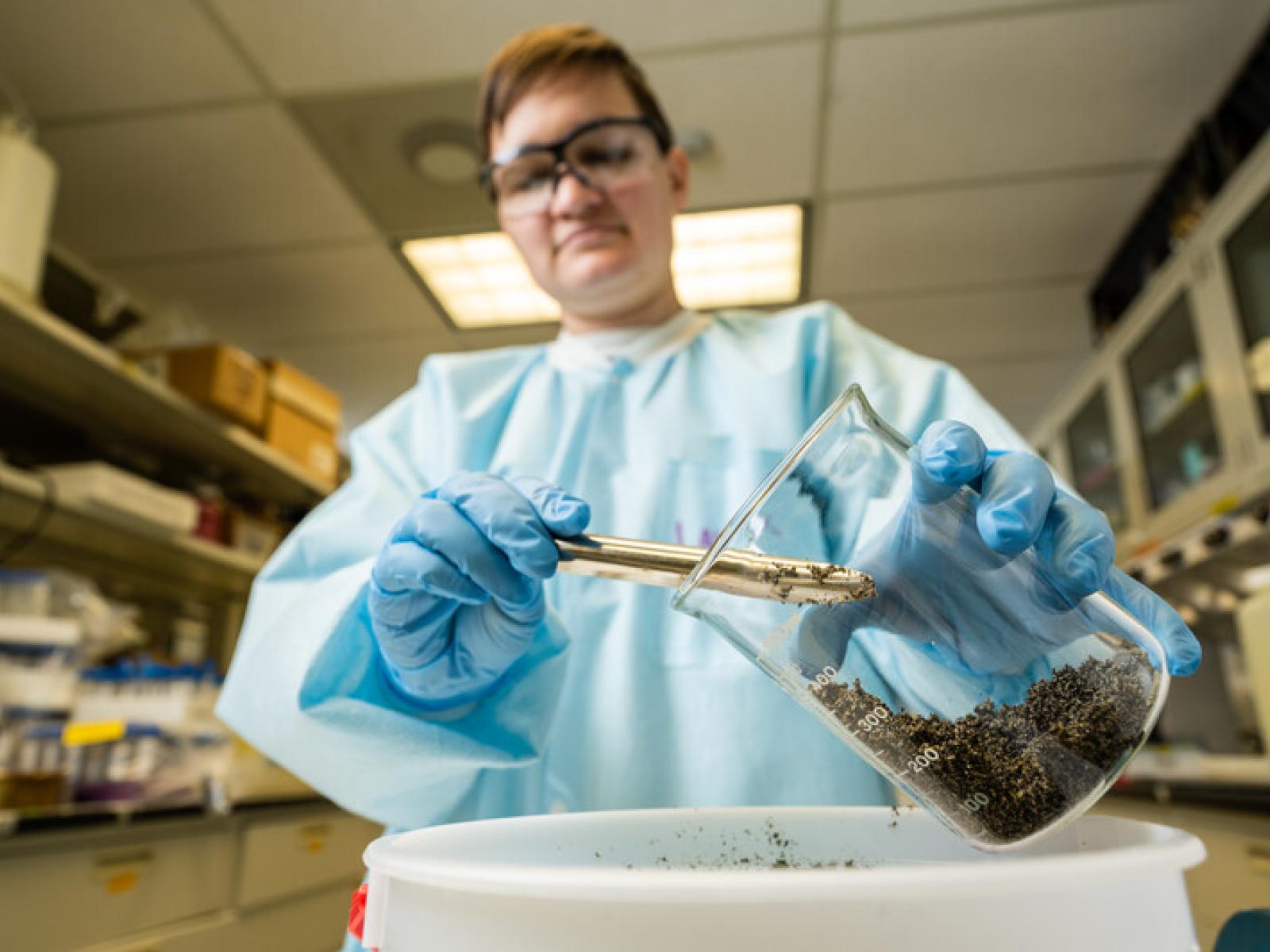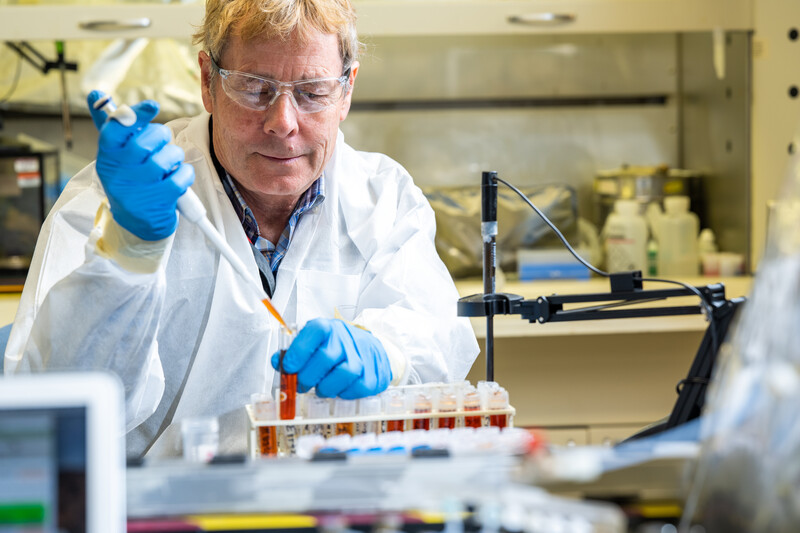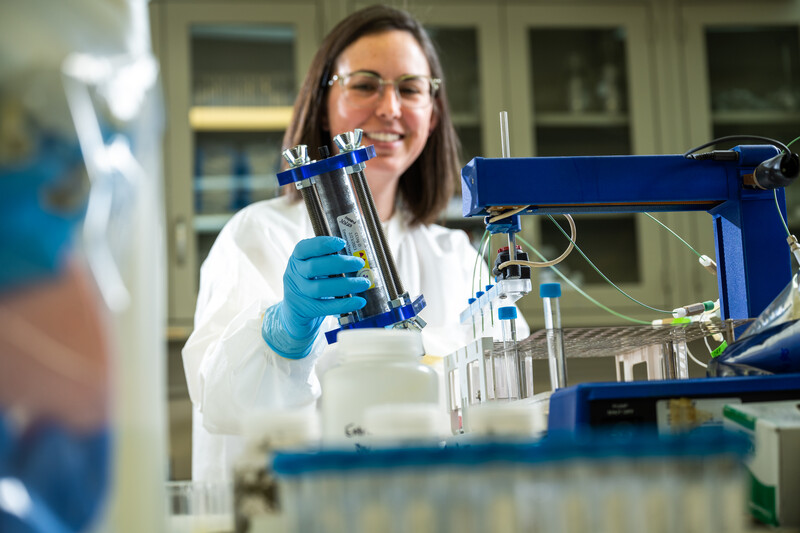PNNL Team Evaluates Technologies for Subsurface Remediation
Deep Vadose Zone program leads treatability study for the Hanford Site’s Central Plateau

As part of a milestone report for the Department of Energy, PNNL researcher Amanda Lawter mixes tin apatite into Hanford Site sediment for experiments. Tin(II) apatite creates an environment in which sensitive contaminants like technetium, chromium, and uranium can reduce to a less mobile species, and not easily become reoxidized.
(Photo by Andrea Starr | Pacific Northwest National Laboratory)
During the four decades that the Hanford Site in southeastern Washington state produced plutonium for nuclear weapons, the radionuclide byproducts and chemical process fluids were stored in underground tanks and released to disposal structures such as trenches and wells. Some of those fluids seeped to the subsurface—called the vadose zone—and in certain cases reached groundwater at 250 to 300 feet deep.
Systems to remove contamination from groundwater are operating and capturing radiological and chemical contaminants of concern. The Department of Energy is planning remediation of subsurface soil contamination, especially in the Hanford Site's Central Plateau—where hundreds of waste sites are located within a 75-square-mile region.
Researchers from the Deep Vadose Zone (DVZ) program at Pacific Northwest National Laboratory (PNNL) recently completed the first phase of a multi-year treatability study assessing nine remediation technologies for potential application at 43 of the most complex waste sites in the Central Plateau. Many of these subsurface remediation technologies were presented at the Waste Management Symposia in March 2024.
“Treatment systems are removing contamination that has reached groundwater, and this work to address deep subsurface contamination in the soil will fold into future remediation efforts on the Central Plateau,” said Naomi Jaschke, director of DOE Hanford’s Soil and Groundwater Division.
PNNL Earth scientist Hilary Emerson is one the lead researchers on the DVZ program.
“Remediation of the Central Plateau is challenging,” Emerson said. “Waste disposal areas are impacted by each other, so they have really complex waste streams with a lot of different contaminants. And on top of that, we can’t just dig hundreds of feet down to get all these contaminants out of the ground.”
Eight of the nine technologies were recommended to advance to phase two for detailed testing under site-specific conditions.
The recommended technologies rely on various processes to reduce or capture contaminants, diminishing their ability to migrate downward toward groundwater or transforming them into nontoxic end products. The main contaminants targeted were technetium-99 (Tc-99), uranium (U), nitrate, and iodine-129 (I-129). These four contaminants are pervasive in the subsurface plumes. Some of the evaluated technologies also treat chromium, strontium, and cyanide.

PNNL environmental engineer Jim Szecsody led two studies on reactive gas technologies.
“Contamination in the vadose zone slowly migrates downward into groundwater, so immobilizing it in the vadose zone decreases risk,” Szecsody said. “The reactive gas technologies being evaluated are attempting to do just that.”
One technology is the injection of 100 percent carbon dioxide (CO2) gas into vadose zone sediment to decrease I-129 mobility. The injected CO2 causes calcite precipitation, and I-129 can co-precipitate in calcite.
“When we say precipitation, we are talking about forming solid phases,” Emerson explained. “The idea is that if we can remove the dissolved contaminants from solution by forming new minerals in sediments, it will reduce their short-term movement in the ground because it is removed from groundwater as a solid precipitate and also reduces long-term movement because the structure of the solid precipitate limits release back into the groundwater.”
Other technologies under consideration include the injection of organic gas into the vadose zone or organic liquids into groundwater to stimulate subsurface microbes that are already in the sediment. The microbes consume the organic resource inputs to transform nitrate into a nonhazardous nitrogen gas and reduce Tc-99, U, and I-129 to insoluble species.
“Microbes naturally exist in the subsurface, even at legacy sites like Hanford. And these microbes can be utilized to help achieve remedial outcomes,” said PNNL Earth scientist Kitt Bagwell. “By introducing a carbon fuel, these microbes will naturally react with mobile contaminants and transform them to immobile forms. Combined with sequestration technologies also being developed, groundwater resources can be protected from these long-lived contaminants.”
Subsurface removal of technetium and uranium using tin(II) apatite, led by PNNL Earth scientist Amanda Lawter, was another technology explored.
“We found that tin(II) apatite was being tested at PNNL a few years back for inclusion in cementitious waste forms to immobilize technetium,” said Lawter. “And we figured out that we could possibly use it in a new way.”
Tin(II) apatite creates an environment in which sensitive contaminants like technetium, chromium, and uranium can reduce to a less mobile species.
“Both technetium and chromium, when they're reduced, will precipitate out of solution,” Lawter said.
Once chromium is reduced it usually doesn't reoxidize and become mobile again. Technetium is another story, however, as once reduced it can easily be reoxidized.
“It needs something more than just reduction to immobilize it, and we're hoping tin(II) apatite can do that,” said Lawter.
Emerson led the studies on reduction and sequestration technologies using liquid phosphate as an amendment.
“These are two main technologies that have previously been used in different areas of Hanford,” she said. “They’re injected into the subsurface and then they slowly precipitate a mineral called apatite, which is very similar to the makeup of our bones.”
The injection of liquid phosphate amendments creates an adsorbent environment for contaminants like uranium and strontium.
“It can grab those contaminants out of solution and hold them in the solid phase in different ways. This is the primary goal for most of the technologies because it slows the contaminants from moving toward groundwater,” Emerson said.

The eight recommended technologies from the study are being evaluated for their potential to advance from smaller-scale batch studies to larger and more advanced flow column experiments that represent field-scale conditions and further evaluate treatment performance and longevity. PNNL DVZ program director Rob Mackley said the team is also considering if combinations of technologies can be tailored to target specific contaminants of concern to maximize treatment efficiency and reduce deployment cost.
“This work illustrates PNNL’s role in supporting DOE and its cleanup contractors in the environmental cleanup mission at the Hanford Site, which directly applies to future remediation decisions and implementation,” Mackley said.
“The DVZ team from all levels including post-doc to lab fellow have opportunities to interact closely with DOE, provide technical briefings to state and federal regulators, and collaborate with remediation managers and the project scientists at the Hanford Site on how to put these results into action. It’s really exciting!”
Published: March 28, 2024